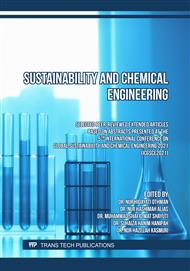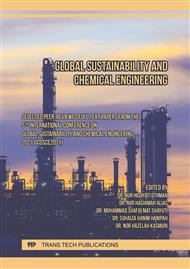[1]
Solomon S., D. Qin, M. Manning, Z. Chen, M. Marquis, K.B. Averyt, M. Tignor and H.L. Miller. IPCC Climate Changes 2007: The Physical Science Basis. Cambridge University Press. Cambridge, United Kingdom (2007) 996 pp.
Google Scholar
[2]
Abushammala, M.F.M., Basri, N.E.A., Kadhum, A.A.H., Basri, H., El-Shafie, A.H. and Mastura, S.S.. Evaluation of methane generation rate and potential from selected landfills in Malaysia. International Journal of Environmental Science and Technology, 11(2), (2014) pp.377-384.
DOI: 10.1007/s13762-013-0197-0
Google Scholar
[3]
Johari, Anwar, Saeed Isa Ahmed, Haslenda Hashim, Habib Alkali, and Mat Ramli. Economic and environmental benefits of landfill gas from municipal solid waste in Malaysia., Renewable and Sustainable Energy Reviews 16, no. 5 (2012): 2907-2912.
DOI: 10.1016/j.rser.2012.02.005
Google Scholar
[4]
Japperi, Nur Shuhadah, et al. Review on landfill gas formation from leachate biodegradation. Malaysian Journal of Chemical Engineering and Technology (MJCET) 4.1 (2021) 39-49.
DOI: 10.24191/mjcet.v4i1.12719
Google Scholar
[5]
Malaysia National Greenhouse Gas Inventory, (2011).
Google Scholar
[6]
Shabdin, Nurul Hidayah, et al. Greenhouse Gas Emissions Trend in Old Landfill, Malaysia. Chemical Engineering Transactions 72 (2019)211-216.
Google Scholar
[7]
Abushammala, M.F., Basri, N.E.A., Basri, H., El-Shafie, A.H. and Kadhum, A.A.H. Regional landfills methane emission inventory in Malaysia. Waste Management & Research, 29(8), (2011) pp.863-873.
DOI: 10.1177/0734242x10382064
Google Scholar
[8]
Izzah, N.; Aziz, H.A.; Hana, M.M.; Gheewala, S.H. Biomass and Bioenergy A review on life cycle assessment of biogas production: Challenges and future perspectives in Malaysia. Biomass Bioenergy, 122, (2019) 361–374. 50.
DOI: 10.1016/j.biombioe.2019.01.047
Google Scholar
[9]
Pillai, J. and Riverol, C. Estimation of gas emission and derived electrical power generation from landfills. Trinidad and Tobago as study case. Sustainable Energy Technologies and Assessments, 29, (2018) pp.139-146.
DOI: 10.1016/j.seta.2018.08.004
Google Scholar
[10]
Shin, H.C., Park, J.W., Kim, H.S. and Shin, E.S. Environmental and economic assessment of landfill gas electricity generation in Korea using LEAP model. Energy policy, 33(10), (2005) pp.1261-1270.
DOI: 10.1016/j.enpol.2003.12.002
Google Scholar
[11]
Ahmad, Salsabila, Mohd Zainal Abidin Ab Kadir, and Suhaidi Shafie. Current perspective of the renewable energy development in Malaysia. Renewable and sustainable energy reviews 15.2 (2011) 897-904.
DOI: 10.1016/j.rser.2010.11.009
Google Scholar
[12]
Abdullah, Wan Syakirah Wan, et al. The potential and status of renewable energy development in Malaysia. Energies 12.12 (2019) 24-37.
Google Scholar
[13]
Arij, Y., Fatihah, S. and Rakmi, A.R. Performance of pilot scale anaerobic biofilm digester (ABD) for the treatment of leachate from a municipal waste transfer station. Bioresource Technology, 260, (2018) pp.213-220.
DOI: 10.1016/j.biortech.2018.03.131
Google Scholar
[14]
Kumar, Ashutosh, and M. P. Sharma. Estimation of GHG emission and energy recovery potential from MSW landfill sites., Sustainable Energy Technologies and Assessments 5 (2014): 50-61.
DOI: 10.1016/j.seta.2013.11.004
Google Scholar
[15]
Cargill, S. M.. Meyer. R; F., Picklyk. D. D., and Urquidi, F. Summary of resource assessment methods resulting from the International Geological Correlation Programme Project 98: Math. Geology. v. 9. no, 3~ 0 (1977) 211-220.
DOI: 10.1007/bf02272383
Google Scholar
[16]
Xia, J. et al. Comparing shear-wave velocity profiles inverted from multichannel surface wave with borehole measurements. Soil Dynamics and Earthquake Engineering, 22(3), (2002) p.181–190.
DOI: 10.1016/s0267-7261(02)00008-8
Google Scholar
[17]
Mahalinga-Iyer, U. and Williams, D.J. Engineering properties of a lateritic soil profile. Engineering Geology, 31(1), (1991) pp.45-58.
DOI: 10.1016/0013-7952(91)90056-q
Google Scholar
[18]
Yip CH, Chua KH. An overview on the feasibility of harvesting landfill gas from MSW to recover energy. ICCBT;(F(28)) (2008) 303–10.
Google Scholar



